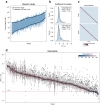NULISA: a proteomic liquid biopsy platform with attomolar sensitivity and high multiplexing
- PMID: 37945559
- PMCID: PMC10636041
- DOI: 10.1038/s41467-023-42834-x
NULISA: a proteomic liquid biopsy platform with attomolar sensitivity and high multiplexing
Abstract
The blood proteome holds great promise for precision medicine but poses substantial challenges due to the low abundance of most plasma proteins and the vast dynamic range of the plasma proteome. Here we address these challenges with NUcleic acid Linked Immuno-Sandwich Assay (NULISA™), which improves the sensitivity of traditional proximity ligation assays by ~10,000-fold to attomolar level, by suppressing assay background via a dual capture and release mechanism built into oligonucleotide-conjugated antibodies. Highly multiplexed quantification of both low- and high-abundance proteins spanning a wide dynamic range is achieved by attenuating signals from abundant targets with unconjugated antibodies and next-generation sequencing of barcoded reporter DNA. A 200-plex NULISA containing 124 cytokines and chemokines and other proteins demonstrates superior sensitivity to a proximity extension assay in detecting biologically important low-abundance biomarkers in patients with autoimmune diseases and COVID-19. Fully automated NULISA makes broad and in-depth proteomic analysis easily accessible for research and diagnostic applications.
© 2023. The Author(s).
Conflict of interest statement
W.F., J.B., Q.H., I.S.A., A.S., A.K., K.C., M.M., X.Q., X.X., S.I., T.Y., R.N., L.W., M.Y., K.E., L.Z., W.X., C.L., C.H.P., C.P., K.Z., A.G., J.H., K.S., D.K., L.F., B.Z., S.C., Y.Y., Y.L., and X.M. are employees and stockholders of Alamar Biosciences. Y.L., W.F., A.G., Y.Y., and S.C. have submitted a patent application to US Patent and Trademark Office pertaining to the methods and compositions of NULISA technology (provisional application No. 62/943,135). The other authors do not claim competing interest.
Figures





Update of
-
NULISA: a novel proteomic liquid biopsy platform with attomolar sensitivity and high multiplexing.bioRxiv [Preprint]. 2023 Jun 2:2023.04.09.536130. doi: 10.1101/2023.04.09.536130. bioRxiv. 2023. Update in: Nat Commun. 2023 Nov 9;14(1):7238. doi: 10.1038/s41467-023-42834-x. PMID: 37090549 Free PMC article. Updated. Preprint.
References
Publication types
MeSH terms
Substances
Grants and funding
LinkOut - more resources
Full Text Sources
Molecular Biology Databases

